
Frogfruit as a Turf Companion
Homeowners may consider growing Frogfruit, Phyla nodiflora as a companion plant in turf areas. Learn the qualities of this groundcover with UF IFAS Extension Escambia County.

Homeowners may consider growing Frogfruit, Phyla nodiflora as a companion plant in turf areas. Learn the qualities of this groundcover with UF IFAS Extension Escambia County.
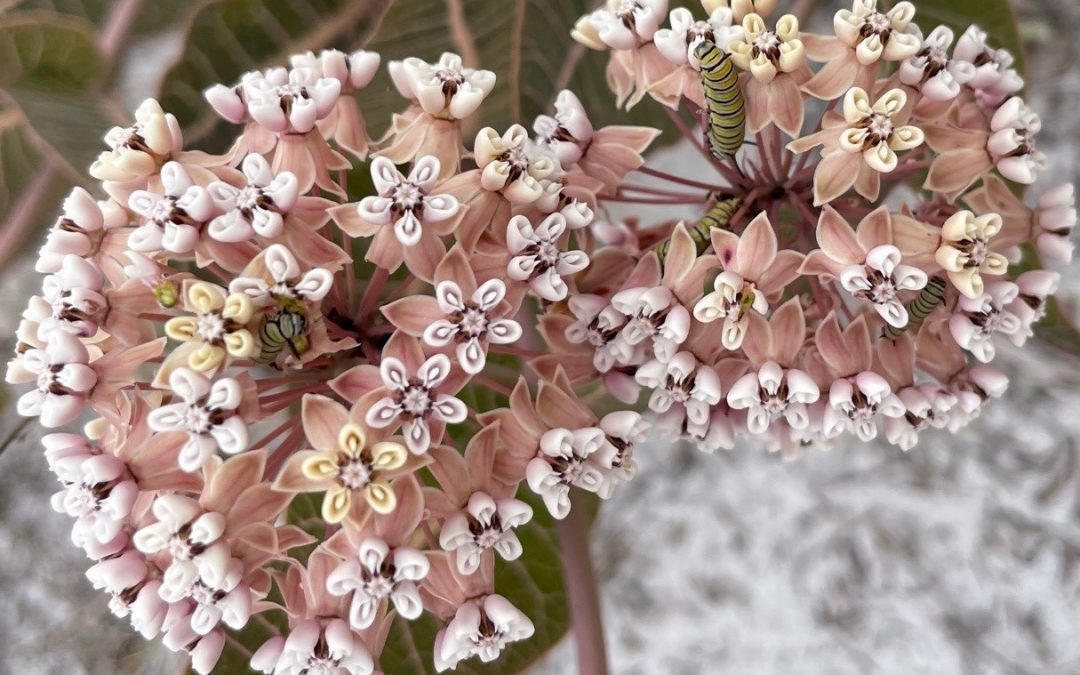
Like finding buried treasure on a desert island, walking up on a mound of sandhill milkweed (Asclepias humistrata) may elicit cries of excitement from someone who understands what they’re seeing. And not unlike searching for pirate booty, there’s a bit of danger involved, too—milkweed is highly toxic.
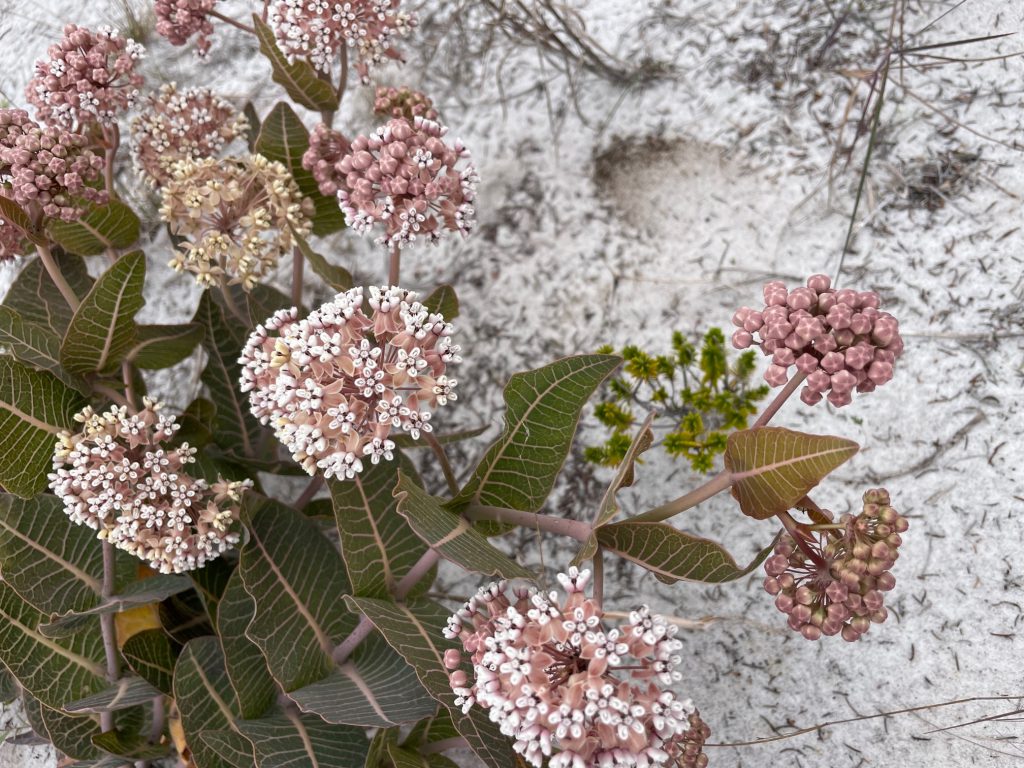
Last month in the dunes of Perdido Key, our Master Naturalist class found robust clusters of eye-catching, pink-tinged leaves, blooms, and buds of sandhill milkweed. Also known as pinewoods milkweed, this variety thrives in dry, sandy soils. It is native to the southeast, found typically in the wilds of Alabama, Mississippi, Louisiana, Georgia, Florida, South Carolina, and North Carolina. Its genus name, “Asclepias” refers to the Greek god of healing—indigenous people have used the plant for medicinal purposes (dysentery treatment and wart removal, in particular) for centuries. The species name humistrata means “spreading,” which describes the growth habit of the plant. Milkweed is highly toxic, so we do not recommend trying any medicinal uses at home! The “milk” part of the common name refers to its sap, which is a thick, sticky, white substance containing that toxic chemical.
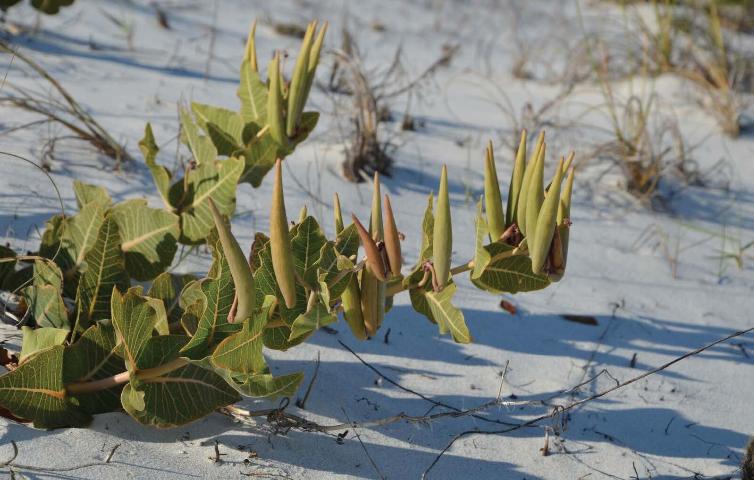
As the only food source for the monarch caterpillar, healthy milkweed plants are crucial for maintaining populations of the famous monarch butterfly. The plant itself is rather complex and beautiful. Its five-petaled blooms grow in tight clusters, on stalks sticking several inches off the ground. The leaves are broad and a deep forest green, edged in the pale maroon/pink of the stems and flowers. The seedpods of milkweed are quite large (3-6” long), resembling pea pods and full of seeds. Each seed has a wispy white fiber attached, which helps it disperse in the wind like a dandelion. The fibers have been used for years as stuffing for pillows and mattresses, and were used for life jackets during World War 2.
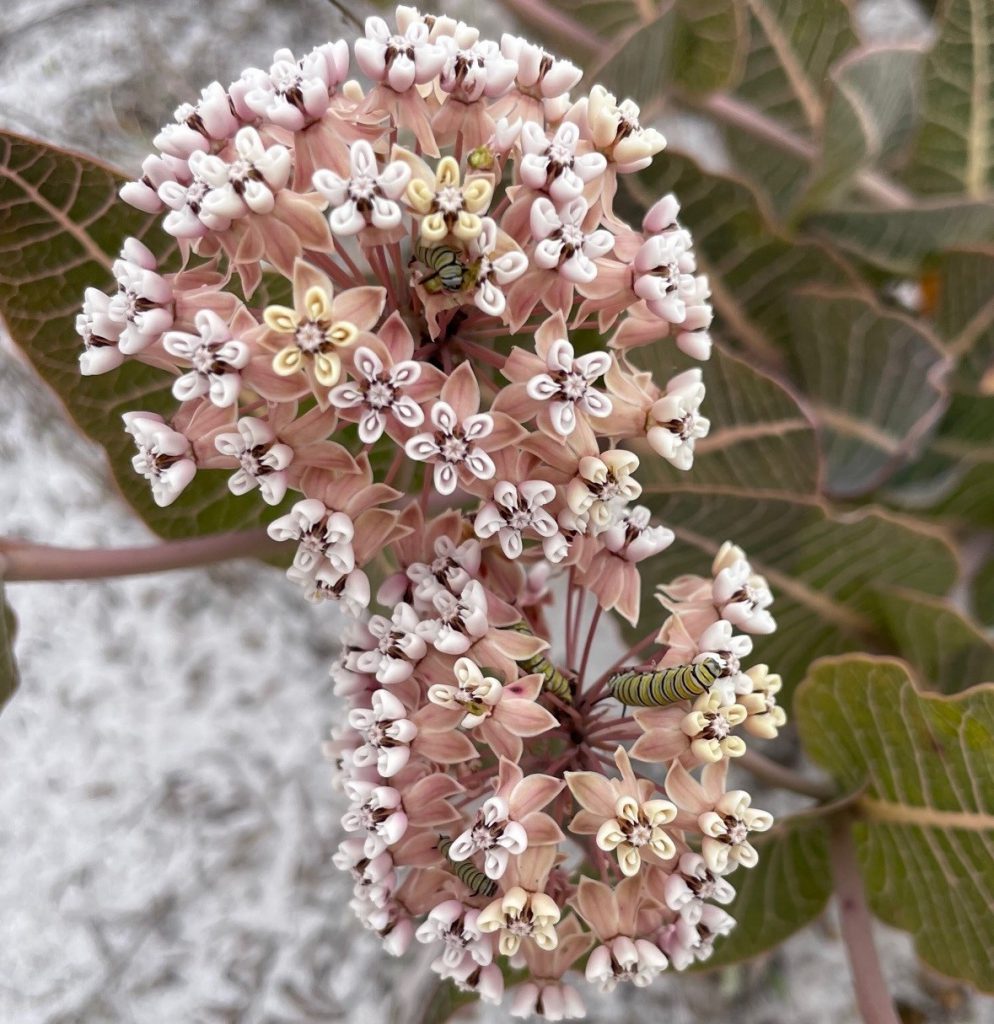
The first cluster of milkweed we found was host to multiple monarch caterpillars, recognizable by their greenish-yellow, white, and black stripes. By the time you see caterpillars, the milkweed is already working its magic, transferring its toxins to the insects but causing them no harm. Monarchs have evolved the capability to digest and metabolize this poison, which would induce heart attacks in nearly any vertebrate animal. Adult monarchs use several nectar sources, including milkweed flowers, and females lay their eggs on the plant so that their young can begin eating once hatched.
In the animal kingdom, red and orange are signs of danger. The bright orange coloration of an adult monarch butterfly serves as a warning to would-be predators to exhibit caution, as the toxins from their food sources stay within the butterfly’s body. The copycat viceroy, soldier, queen, and Gulf fritillary butterflies benefit from this trait by using mimicry in their own orange coloration to ward off predators.


Do you enjoy a tasty bowl of fruit in the morning? Or maybe a hot steaming cup of coffee? If the answer is yes, then raise (or tip) your hat to our pollinators. About 75% of food crops depend on pollination to some extent, but pollinators provide the bulk of the pollination for over 80% of the world’s flowering plants. A pollinator can be birds, bats, or even small mammals but, insects such as ants, bees, beetles, wasps, butterflies, and moths do the bulk of the pollination that affects our daily lives.
Plants normally benefits from attracting a particular type of pollinator to their flowers, ensuring transfer and hopefully resulting in reproduction. The pollinator benefits from its adaptation of a particular flower with different traits to access nectar and pollen. These floral traits include odor, color, size, flower shape, reward type, amount, nectar composition, and timing of flowering. This plant pollinator interaction is known as pollination syndrome.
Did you know –
Did you Know-
Everyone can contribute to pollinators by creating a home garden. Pollinators will make use of food and habitat anywhere it is found – roadsides, open fields, pastures, backyard flower gardens etc. One can be pollinator friendly by doing any of the activities below:
Helpful Hint: Did you know dandelions are the first food for bees emerging in the spring. Leave them in your yard and feed the bees!
For more information, please contact your local county extension office or visit the following websites: Pollination – UF/IFAS Extension (ufl.edu); WEC247/UW291: Conservation of Bats in Florida (ufl.edu); https://sfyl.ifas.ufl.edu/lawn-and-garden/pollination/; https://blogs.ifas.ufl.edu/sarasotaco/2022/09/14/pollinators-its-not-all-about-the-bees/; and https://www.usda.gov/peoples-garden/pollinators.
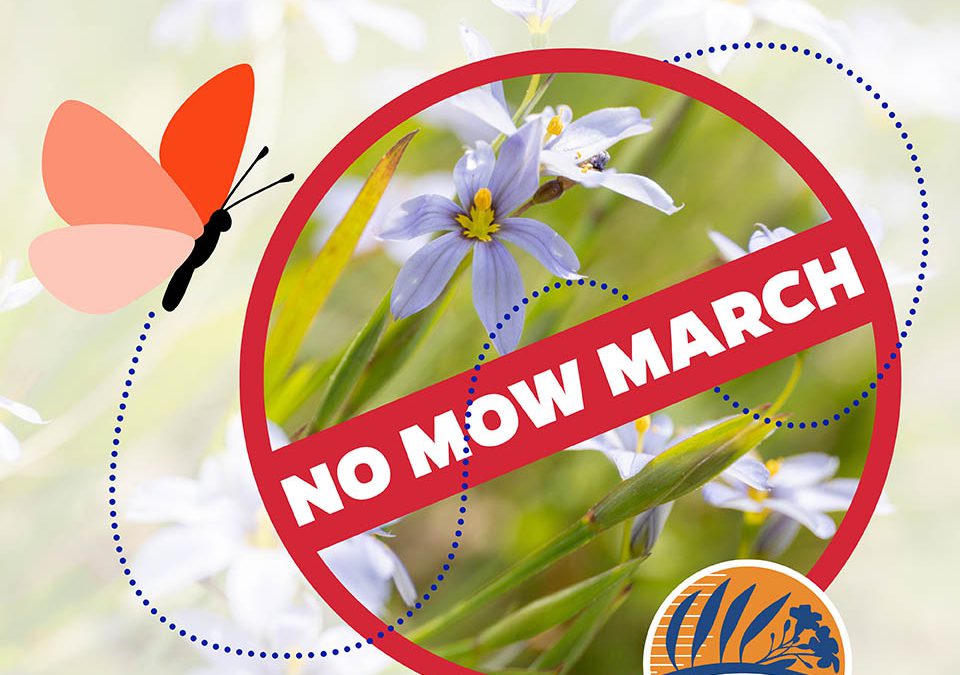
Need an excuse to not mow your lawn this month? UF/IFAS Extension agents in the Florida Panhandle are asking residents to skip their soon-to-be-weekly outdoor chore until the calendar flips to April.
The idea for “No Mow March” is borrowed from “No Mow May,” a concept begun in the United Kingdom that has now spread to northern parts of the United States.
“Obviously, our lawns are growing way too quickly by the time May rolls around,” said Beth Bolles, UF/IFAS Escambia County horticulture agent who is leading the pilot effort this year. “Here in North Florida, March is our transition period, when grass is exiting dormancy. But it’s also when pollinators are starting to become more active, so it’s the perfect time to celebrate them and promote their health and habitat.”
Bolles is quick to point out, though, that the month is about more than just turf.
“We recognize that some communities have rules to follow regarding their lawns,” she said. “There are other things you can do to encourage pollinators to visit, whether it’s container plants or adding new shrubs or pollinator houses. We encourage everyone to find their own way to participate.”
The first step in participating is to sign the pledge at go.ufl.edu/NoMowMarch. Visitors can also use the website to find virtual or in-person events geared to the topic, learn tips for adhering to homeowners association guidelines while still promoting pollinators, and record observations to a No Mow group on iNaturalist.
Follow the Gardening in the Panhandle Facebook page to stay in the know throughout No Mow March.
—Kirsten Romaguera, UF/IFAS public relations specialist,
O: 352-294-3313, C: 936-689-2754, kromaguera@ufl.edu
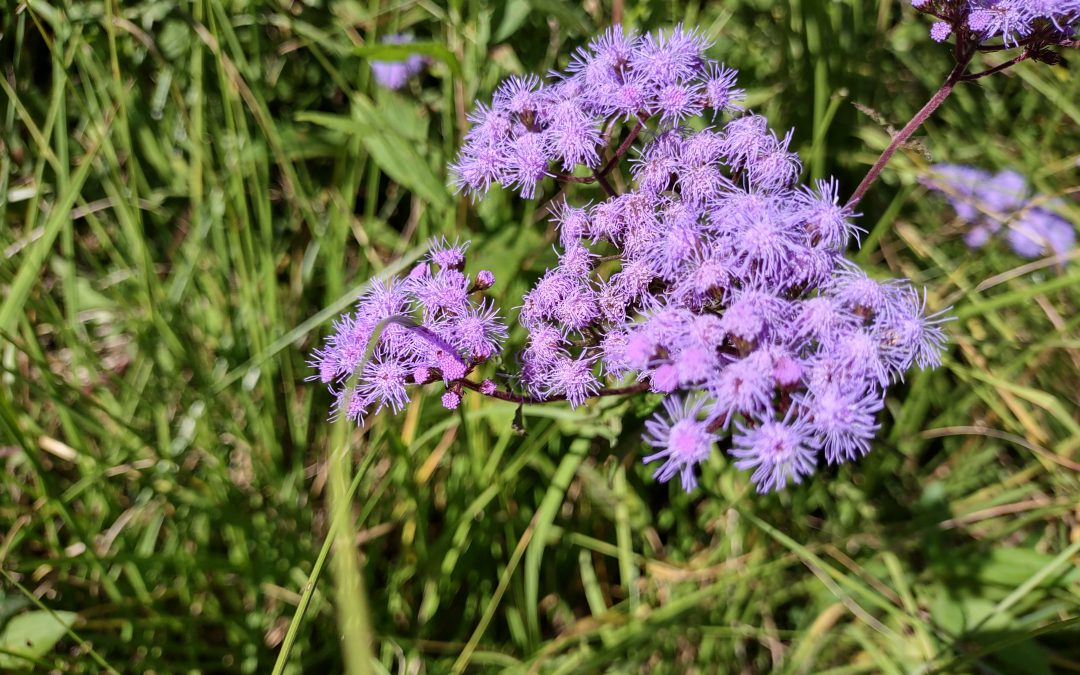
October is the premier wildflower month in the Panhandle. Nighttime temperatures drop, days shorten, pollinators emerge, and many native plants explode into flower. Of all the native fall-flowering Panhandle wildflowers, maybe the most striking is currently in full bloom, the Mistflower (Conoclinium coelestinum)!
Mistflower is a low growing, spreading native perennial (1-2’ in height) found in sunny, moist areas of meadows and near rivers, ponds, and creeks throughout much of the United States from New York to Florida and even west as far as Texas and Nebraska. This common native wildflower is conspicuously one of the few native plants in our area that has blue flowers, making Mistflower easy to spot in a sea of yellow, orange, purple, pink, and white wildflowers. The flowers appear as little puffs of purply-blue due to the lack of ray florets (think the outer yellow “petals” of sunflowers), possessing only disk florets (think the inner part of sunflower heads) with long blue, fuzzy-appearing stamens. Mistflower is attractive to more than just wildflower watchers as well, it’s a magnet for nectar-seeking butterflies as well; Eastern Swallowtails, Great Purple and Juniper Hairstreaks, and others are often found feeding on the flowers.
As lovely as Mistflower is in the wild, it’s probably best left for folks enjoy there, especially those who prefer an orderly yard. Mistflower will indeed grow great in moist areas of pollinator gardens and landscapes, requiring only ample sunlight and rainfall, but it is very aggressive. Its spreading nature via its rhizomatous root system and prolific seed production often lead to it becoming a weedy nuisance in more manicured landscapes. But, if chaos and fall bursts of blue erupting at random throughout your garden don’t bother you, by all means, seek out Mistflower for purchase through seed catalogs and local native nurseries. For more information on Mistflower and other fall-blooming native wildflowers, contact us at the UF/IFAS Calhoun County Extension office! Happy Gardening.